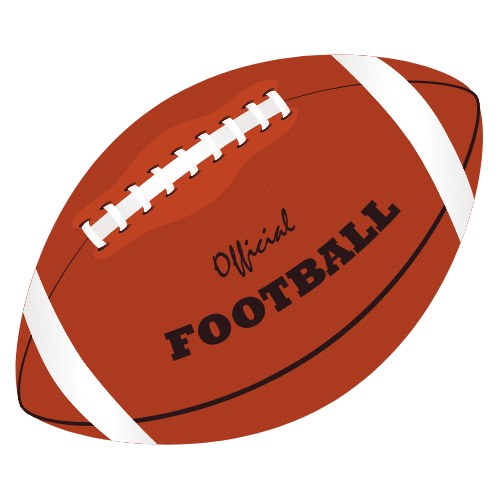Field Diagrams

Important note: Although the diagram above shows the limit lines at 12′, IFAF limit lines should normally be 18′ from the sidelines/end lines (Rule 1-2-3-a).



Notes for groundsmen
These notes accompany the field diagram as a summary of requirements for the marking of the field. For full details, see Rule 1-2.
- There is no such thing as a metric American football field. All measurements are in yards, feet and inches.
1 yard = 3 feet = 36 inches = 91.44cm 1 foot = 12 inches = 30.48cm
1 inch = 2.54cm
1 yard = 36 inches (91.44cm), but may be shortened to no less than 34.12 inches (86.67cm) only if necessary to fit a 100-yard field of play plus two 10-yard end zones within the available playing surface. If the length of the field is reduced in this way, all other field dimensions and markings stated in the rules must be reduced commensurately. - A full sized field is 360ft long and 160ft wide, consisting of two 10yd end zones and twenty 5yd grid segments. If there is insufficient length, it may be shortened to 330ft by taking two 5yd segments out of the middle (i.e. the 45yd line thus becomes the halfway line). If absolutely necessary, up to a further 18ft may be saved by reducing the size of both end zones to the minimum allowed 7yds. A legal field cannot therefore be marked if there is less than 104yds (312ft) between the goal posts.
- Note that the width of the field is significantly less than for sports such as soccer, rugby or hockey and that it cannot be varied.
- Measurements are made from the inside edge of the boundary lines. The entire width of the goal line shall be in the end zone.
- Yard lines across the field at 5yd intervals between the goal lines (i.e. NOT in the end zones) are essential: they are relied upon for accurate measurement of the distance the ball is advanced.
- The hash marks lines are 60ft from each sideline. (N.B. Some field diagrams show these to be 53ft 4in or 70ft 9in from the sidelines — those are not correct for British/international games.) Each hash mark should be 2ft long (i.e. from a point 60ft from the sideline to a point 58ft from the sideline) on each side of the field. The hash marks do NOT extend into the end zones.
- Similar 2ft long lines should be marked starting 4in inside each sideline (between the goal lines). These should line up with the hash marks in the middle of the field to give a series of consistent reference points for aligning the ball.
- There must be either numbers or marks 27ft from each sideline on every 10yd line (but not the 5yd lines). If numbers then it is the top of each number that is 27ft from the sideline. The proper size of the numbers is 6ft x 4ft but they can be smaller if necessary. If not numbers, a 1ft long mark should be made 27ft in from each sideline on each 10yd line.
- There should be two (adjacent) boxes drawn outside each sideline, stretching from a point 25yds from each goal line. These boxes are shorter if segments are taken out of the middle of the field since the two end points of them are fixed in relation to the goal lines. Stretching from 6ft to 12ft outside the sideline is the coaching box. Stretching from 12ft as far as there is room for it is the team area. These are the areas in which coaches and substitutes must stay during play.
- Outside the sidelines and end lines, there should be a set of dashed limit lines drawn, if possible, 18ft away from the field of play. This marks the boundary of the field, and all spectators, photographers, cheerleaders, etc. should be outside it.
- If spectators are not confined to a particular area (e.g. the stands), then for reasons of safety there should be a rope or something similar that keeps them well behind the limit lines.
- For safety reasons goal posts may not be inside the field. They must be on the end lines or, failing that, outside them. If the goal posts cannot be moved, the length of the field must be reduced.
- The top of the crossbar should be 10ft from the ground. The uprights should be 18ft 6in between the insides of the uprights. The uprights should be at least 30ft high. (N.B. A standard rugby goal that has a 3m crossbar and uprights 5.6m apart is acceptable.) The posts must be padded with resilient material from the ground to a height of at least 6ft.
- Soft flexible four-sided pylons 4in x 4in with an overall height of 18 inches, which may include a 2in space between the bottom of the pylon and the ground, are recommended. They should be red or orange in colour and placed at the inside corners of the eight intersections of the sidelines with the goal lines and end lines. The pylons marking the intersections of the end lines and inbounds lines extended should be placed 3ft outside the end lines.
- All field dimension lines should be 4in in width with a white non-toxic material (Exception: sidelines and end lines may exceed 4in). If white is unsuitable, choose another contrasting colour.
- Advertising or decorative markings on the field are permissible. In the end zone, they must not be closer than 4ft to any line unless in a contrasting colour. In the field of play, they must not obliterate any line.


